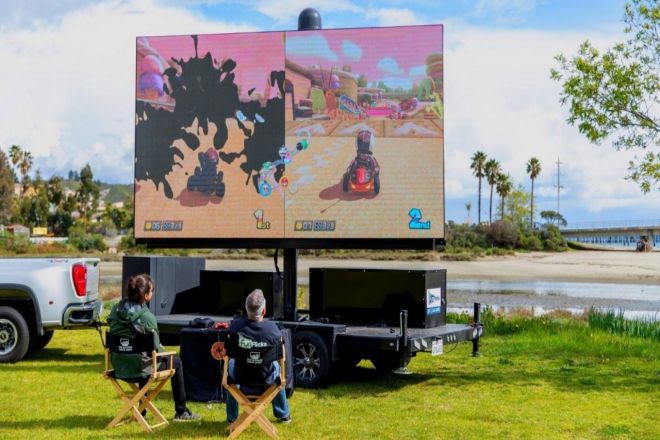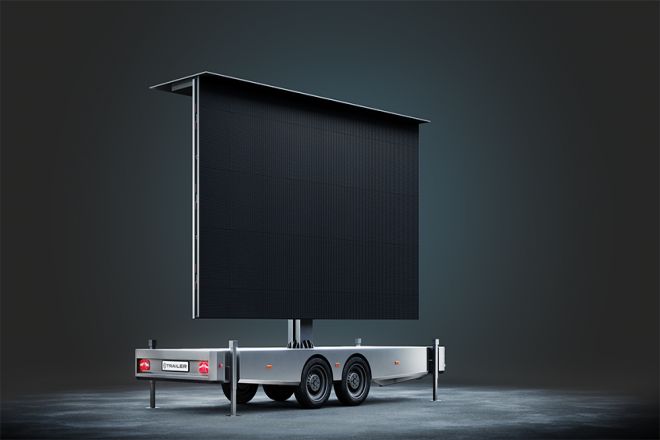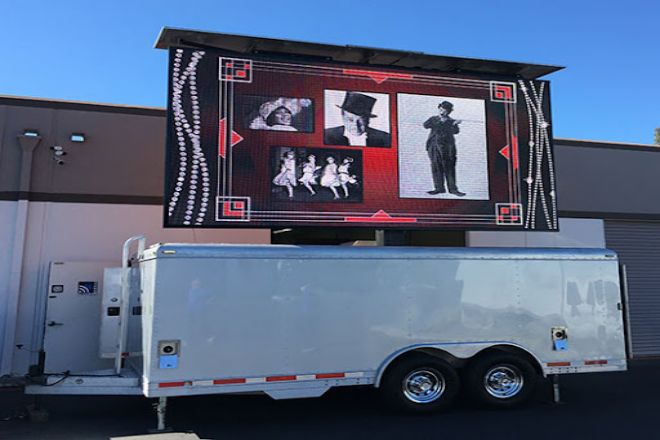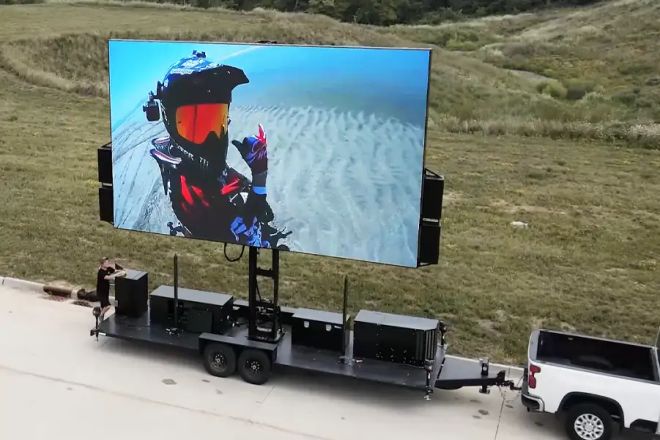Introduction

In today’s era of information explosion, LED trailer screens have become star products in the fields of outdoor advertising, event promotion, road guidance, etc., with their unique mobility, high brightness, and visual impact.
They not only add beautiful scenery to the urban landscape but also become an important tool for corporate publicity and brand building. However, facing the dazzling array of LED trailer screen products on the market, how to choose a product that not only meets their own needs but also has excellent quality has become the focus of many consumers.
1. Clarify the use needs and scenarios

Before deciding to buy an LED trailer screen, the first task is to clearly define its use needs and specific scenarios, which will directly affect the subsequent selection and decision-making process.
1). Use scenario analysis:
- Urban roads:
If the trailer screen is planned to be used on urban roads, special attention should be paid to its display effects during the day and at night, and whether it will interfere with traffic.
At the same time, considering the complexity and diversity of urban roads, trailer screens should have high adaptability and flexibility.
- Highways:
Trailer screens on highways are mainly used for long-distance information dissemination, so models with high brightness and long visible distances should be selected. At the same time, due to the high speed of vehicles on highways, the content update speed and simplicity of information transmission of trailer screens are also particularly important.
- Event site:
The event site requires high flexibility and portability of trailer screens so that they can be quickly set up and moved. In addition, the number, distribution, and viewing angle of the audience on site must be considered to ensure that the display effect of the trailer screen can cover the entire event area.
2). Content requirements:
- Content type:
Make it clear whether the trailer screen will be mainly used to display text, pictures, or video content. Different types of content have different requirements for the resolution, color expression, and refresh rate of the trailer screen.
For example, video content requires higher resolution and refresh rate to ensure smooth playback; while text content pays more attention to clarity and readability.
- Resolution and color:
Choose the appropriate resolution and color expression according to content requirements. High resolution and wide color gamut can provide more delicate and realistic display effects but will also increase costs and power consumption. Therefore, a trade-off needs to be made on the premise of meeting the needs.
3). Mobility requirements:
- Movement frequency:
Evaluate whether the trailer screen needs to be moved frequently. If it needs to change positions frequently or be used for touring displays, it is necessary to choose a model that is lightweight, easy to carry, and easy to install and disassemble.
- Stability and safety:
During the movement, the stability and safety of the trailer screen are crucial. It is necessary to ensure that the trailer screen has a strong structure, good shock resistance, and is not easily damaged during transportation and installation. At the same time, safety configurations such as brake systems and fixtures must also be considered to ensure the stability and safety of the trailer screen during driving.
2. Pay attention to the core performance parameters of LED trailer screens
When purchasing LED trailer screens, core performance parameters are an important basis for evaluating product quality and applicability. The following are several key indicators that require special attention:
1). Brightness and contrast:
- Brightness:
For outdoor LED trailer screens, high brightness is the key to ensuring that content can still be clearly displayed in strong light environments (such as direct sunlight). High brightness not only improves visibility but also enhances the communication effect of information. Therefore, when choosing, products with higher brightness indicators should be given priority.
- Contrast:
Contrast determines the degree of difference between black and white in the picture, and is also a key factor affecting color levels and detail expression. Trailer screens with high contrast can present richer and more vivid colors, giving viewers a better visual experience. Therefore, under the premise that the brightness meets the standard, you should also pay attention to choosing products with higher contrast.
2). Waterproof and dustproof level:
Since LED trailer screens are usually used in outdoor environments, the waterproof and dustproof level has become an important indicator that cannot be ignored.
A higher waterproof and dustproof level (such as IP65 or higher) means that the product can better resist the erosion of adverse weather conditions such as rain and dust, thereby extending the service life and reducing maintenance costs. Therefore, when purchasing, be sure to pay attention to the waterproof and dustproof level information of the product.
3). Viewing angle and visible distance:
- Viewing angle:
The viewing angle refers to the maximum angle range in which the screen content can be clearly seen from the left and right sides of the front of the screen. A larger viewing angle range means that the trailer screen can cover a wider viewing area and meet the viewing needs of the audience at different angles.
Therefore, when choosing, you should choose a product with a suitable viewing angle according to the actual usage scenario and needs.
- Visual distance:
The visual distance refers to the maximum distance range in which the audience can clearly see the screen content. This indicator is related to factors such as the resolution, brightness, and viewing environment of the trailer screen.
When choosing, you should evaluate whether the visual effect of the product meets the needs based on the expected viewing distance. For example, if the trailer screen is used for long-distance information dissemination on the highway, it is necessary to choose a product with a longer visible distance to ensure effective communication of information.
3. Material and structural design considerations

When purchasing LED trailer screens, material and structural design considerations are also crucial, which directly affect the durability, performance, and ease of use of the product.
- LED chip quality:
The LED chip is the core component of the trailer screen, and its quality directly determines the display effect and service life of the screen. Therefore, it is crucial to choose well-known brands and energy-efficient LED chips.
Well-known brands usually have stricter quality control standards and more advanced technical support, which can ensure that the LED chips maintain stable performance during long-term use. At the same time, energy-efficient LED chips can also effectively reduce energy consumption and reduce operating costs.
- Cabinet material:
The cabinet is a key part of protecting the LED chip and circuit, and the choice of its material directly affects the durability and heat dissipation performance of the trailer screen. Strong and durable cabinet materials such as aluminum alloy or stainless steel can resist external impact and erosion and extend the service life of the product.
In addition, these materials also have good heat dissipation performance, which helps to reduce the heat generated by the LED chip during operation and improve the overall stability and reliability.
- Structural design:
The overall structural design of the trailer screen needs to take into account multiple aspects, such as lightness and portability, easy installation, and seismic resistance.
The light and portable design allows users to quickly move and deploy trailer screens between different scenes; easy installation can reduce installation time and labor costs, and good seismic resistance can ensure that the trailer screen is not easily damaged during driving or transportation.
Therefore, when choosing, you should pay attention to whether the structural design of the product is reasonable and stable and consider whether it is equipped with the necessary fixings and shock absorption measures. At the same time, you should check whether the product’s connectors and fasteners are firm and reliable to ensure the stability and safety of the overall structure.
4. Control system and software compatibility
ol system, including common operating systems, media playback software, content editing tools, etc. At the same time, you should also pay attention to whether the control system provides an open API interface or SDK development kit so that secondary development or customized services can be carried out as needed.
- Remote control capability:
The remote control function brings great convenience to the management and maintenance of trailer screens. Through remote control, users can monitor and adjust the trailer screen in real-time at any location, including content updates, brightness adjustments, troubleshooting, etc.
This is especially important for trailer screen networks that need to frequently change display content or are distributed in multiple locations. When purchasing, you should understand whether the control system has remote control functions and consider the convenience, real-time, and security of its remote operation.
In addition, attention should be paid to the collaborative working ability of the remote control system and the local control system of the trailer screen to ensure that the two can be seamlessly connected and jointly achieve efficient and stable operation.
5. After-sales service and technical support

After-sales service and technical support are indispensable when purchasing LED trailer screens. A high-quality after-sales service system and technical support team can ensure that users get timely and effective help during use, thereby improving user satisfaction and equipment operation efficiency.
- After-sales service system:
It is crucial to choose a supplier with a complete after-sales service system. This includes clear after-sales service processes, fast response mechanisms, professional service teams, and reasonable service fees.
Users should carefully understand the supplier’s after-sales service policy, including warranty period, maintenance process, return and exchange policy, etc., and try to choose suppliers that provide national joint warranty or door-to-door service.
In addition, users can also evaluate the quality and reputation of their after-sales service by viewing the supplier’s customer reviews, case sharing, etc.
- Technical training:
Technical training is the key to ensuring that users can master the use and maintenance methods of trailer screens. Suppliers should provide comprehensive technical training services, including knowledge and skills in product operation, daily maintenance, troubleshooting, etc.
Users should pay attention to whether the supplier provides free technical training courses, as well as the richness and practicality of the training content. In addition, suppliers can also provide auxiliary resources such as online technical support and video tutorials to help users better understand and use the products.
- Spare parts supply:
Spare parts supply is an important guarantee for the long-term and stable operation of equipment. Users should ask suppliers whether they provide spare parts supply services and understand information such as the types, quantities, prices, and supply cycles of spare parts.
When purchasing, users can also consider signing a spare parts supply agreement or a long-term cooperation agreement with suppliers to ensure that they can get support quickly when parts need to be replaced.
In addition, users can also pay attention to information such as the supplier’s spare parts inventory, supply chain management capabilities, and spare parts quality to evaluate the reliability and stability of its spare parts supply.
6. Compliance and safety performance
When purchasing LED trailer screens, it is crucial to ensure the product’s compliance and safety performance. This is not only related to the legal use of the product but also directly related to the safety and reliability during use.
- Product certification:
When purchasing an LED trailer screen, the first thing to confirm is whether the product has passed the safety certification and environmental protection certifications of the relevant country or region. These certifications usually include CE, UL, RoHS, etc., which represent the safety, quality, and environmental protection standards of the product in different aspects.
Certified products mean that their design, production, and use comply with the relevant regulations and standards and can provide users with a safer and more reliable use experience.
- Electrical safety:
Electrical safety is an important link that cannot be ignored when using LED trailer screens. When purchasing, you should carefully check whether the electrical system of the trailer screen meets the safety standards, including whether the material, specifications, and wiring methods of components such as power cords, plugs, switches, etc. are compliant.
At the same time, understand the product’s protection measures such as leakage prevention and short circuit prevention to ensure that no electrical accidents occur during use.
- Traffic safety:
If the LED trailer screen is planned to be used on the road, especially on highways or urban roads, then its design must comply with traffic safety regulations. This includes the size, weight, shape, color, and other aspects of the trailer screen to ensure that it does not cause interference or danger to other vehicles and pedestrians.
In addition, attention should be paid to the fixing method and stability of the trailer screen to prevent accidents such as falling off or overturning during driving.
7. Price and cost-effectiveness evaluation
After determining the performance parameters and safety performance of the product, the price and cost-effectiveness evaluation becomes the key factor in the final decision.
- Market price research:
Understand the price level of similar products on the market through multiple channels, including official websites, e-commerce platforms, industry exhibitions, etc.
This helps avoid being confused by high or low prices and helps you understand the market situation and price trends more clearly. At the same time, you can also compare the price differences of products of different brands and models to provide data support for subsequent cost-effectiveness evaluation.
- Cost-effectiveness evaluation:
Cost-effectiveness evaluation is a process that comprehensively considers multiple factors such as product performance, material quality, and after-sales service.
When evaluating, the performance parameters of different products can be quantitatively compared, such as brightness, contrast, waterproof and dustproof level, etc.; at the same time, non-quantitative factors such as material quality, brand reputation, and after-sales service can be combined for comprehensive evaluation.
Finally, those products with superior performance, reliable quality, perfect after-sales service, and reasonable prices are selected as the purchase object. Such an evaluation method can ensure that cost-effective LED trailer screen products are purchased.
Conclusion
In summary, buying an LED trailer screen is a decision-making process that requires careful consideration of many factors. From clarifying the use requirements and scenarios to focusing on core performance parameters, material and structural design, control system and software compatibility, after-sales service and technical support, compliance, and safety performance to the final price and cost-effectiveness evaluation, every link is crucial.
Finally, if you want to know more about LED display screens, please get in touch with us.
